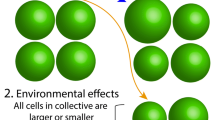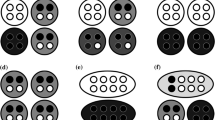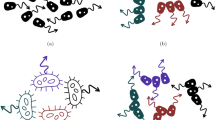Abstract
With a few exceptions, the literature on evolutionary transitions in individuality (ETIs) has mostly focused on the relationships between lower-level (particle-level) and higher-level (collective-level) selection, leaving aside the question of the relationship between particle-level and collective-level inheritance. Yet, without an account of this relationship, our hope to fully understand the evolutionary mechanisms underlying ETIs is impeded. To that effect, I present a highly idealized model to study the relationship between particle-level and collective-level heritability both when a collective-level trait is a linear function and when it is a nonlinear function of a particle-level trait. I first show that when a collective trait is a linear function of a particle-level trait, collective-level heritability is a by-product of particle-level heritability. It is equal to particle-level heritability, whether the particles interact randomly or not to form collectives. Second, I show that one effect of population structure is the reduction in variance in offspring collective-level character for a given parental collective. I propose that this reduction in variance is one dimension of individuality. Third, I show that even in the simple case of a nonlinear collective-level character, collective-level heritability is not only weak but also highly dependent on the frequency of the different types of particles in the global population. Finally, I show that population structure, because one of its effects is to reduce the variance in offspring collective-level character, allows not only for an increase in collective-level character but renders it less context dependent. This in turn permits a stable collective-level response to selection. The upshot is that population structure is a driver for ETIs. These results are particularly significant in that the relationship between population structure and collective-level heritability has, to my knowledge, not been previously explored in the context of ETIs.





Similar content being viewed by others
Notes
Note that because I am interested in the evolutionary origins of individuality, by ‘individual’ I will mean throughout ‘evolutionary’ or ‘Darwinian individual.’ For other definitions of individuality and organismality, see Pepper and Herron (2008), Gilbert et al. (2012), Lidgard and Nyhart (2017a), Godfrey-Smith (2013). Note also that there is some tension with the view that a unit of selection can be equated with Darwinian individuality. In fact, one might consider that individuality ‘emerges’ at one level when not one but a large number of traits at that level exhibit differences in fitness and heritability, while Lewontin’s conditions are trait specific. I will put these problems to the side here and consider the two as synonymous.
For a similar approach to mine, in which the authors analyze the heritability of ‘heterozygosity’ in the context of diploid sexual species in which variation in the environment is not considered, see Nietlisbach et al. (2016).
Recall that I assume that all particles produce the same number of offspring at each generation in an infinitely large population, so that I keep both selection (i.e., difference in fitness associated with differences in phenotype) and drift out of the picture here.
For the difference between the binomial and hypergeometric distributions, see Wroughton and Cole (2013).
For a model based on the ‘wrinkly spreader’ strain of Pseudomonas fluorescens (see Rainey and Rainey 2003; Hammerschmidt et al. 2014), in which a fitness trade-off between collective viability and fecundity is considered, see Rainey and Kerr (2010). The sort of trade-off I have in mind here is slightly different as it concerns fidelity of transmission and fertility.
The notion of allele used here is similar to the one presented in Lu and Bourrat (2018), that is following an evolutionary conception of the gene, not a molecular one.
Thanks to Jonathan Hodge for pointing out this reference to me.
References
Black AJ, Bourrat P, Rainey PB (forthcoming) Ecological scaffolding and the evolution of individuality during the transition from cells to multicellular life
Bouchard F, Huneman P (eds) (2013) From groups to individuals: evolution and emerging individuality. Vienna series in theoretical biology. The MIT Press, Cambridge
Bourrat P (2014) From survivors to replicators: evolution by natural selection revisited. Biol Philos 29(4):517–538
Bourrat P (2015a) How to read ‘Heritability’ in the recipe approach to natural selection. Br J Philos Sci 66(4):883–903
Bourrat P (2015b) Levels of selection are artefacts of different fitness temporal measures. Ratio 28(1):40–50
Bourrat P (2015c) Levels, time and fitness in evolutionary transitions in individuality. Philos Theory Biol 7:1–17. https://doi.org/10.3998/ptb.6959004.0007.001
Bourrat P (2016) Generalizing contextual analysis. Acta Biotheor 64(2):197–217
Bourrat P, Griffiths PE (2018) Multispecies individuals. Hist Philos Life Sci 40(2)
Bourrat P, Lu Q (2017) Dissolving the missing heritability problem. Philos Sci 84(5):1055–1067
Bourrat P, Lu Q, Jablonka E (2017) Why the missing heritability might not be in the DNA. BioEssays 39(7):1700067
Buss LW (1983) Evolution, development, and the units of selection. Proc Natl Acad Sci 80(5):1387–1391
Buss LW (1987) The evolution of individuality. Princeton University Press, Princeton
Calcott B, Sterelny K (eds) (2011) The major transitions in evolution revisited. Vienna series in theoretical biology. MIT Press, Cambridge
Clarke E (2010) The problem of biological individuality. Biol Theory 5(4):312–325
Clarke E (2013) The multiple realizability of biological individuals. J Philos 110(8):413–435
Clarke E (2016a) A levels-of-selection approach to evolutionary individuality. Biol Philos 31(6):893–911
Clarke E (2016b) Levels of selection in biofilms: multispecies biofilms are not evolutionary individuals. Biol Philos 31(2):191–212
Damuth J, Heisler IL (1988) Alternative formulations of multilevel selection. Biol Philos 3(4):407–430
Dawkins R (1982) The extended phenotype: the long reach of the gene. Oxford University Press, New York
De Monte S, Rainey PB (2014) Nascent multicellular life and the emergence of individuality. J Biosci 39(2):237–248
Downes SM (2009) Heritability. Stanford encyclopedia of philosophy. https://plato.stanford.edu/entries/heredity/
Ereshefsky M, Pedroso M (2013) Biological individuality: the case of biofilms. Biol Philos 28(2):331–349
Falconer TE (1996) Introduction to quantitative genetics, 4th edn. Longman, Essex
Gilbert SF, Sapp J, Tauber AI (2012) A symbiotic view of life: we have never been individuals. Q Rev Biol 87(4):325–341
Godfrey-Smith P (1992) Additivity and the units of selection. In: PSA: Proceedings of the Biennial Meeting of the Philosophy of Science Association, vol 1992, pp 315–328. https://doi.org/10.2307/192764
Godfrey-Smith P (2007) Conditions for evolution by natural selection. J Philos 104:489
Godfrey-Smith P (2008) Varieties of population structure and the levels of selection. Br J Philos Sci 59(1):25–50
Godfrey-Smith P (2009) Darwinian populations and natural selection. Oxford University Press, Oxford
Godfrey-Smith P (2013) Darwinian individuals. In: Bouchard F, Huneman P (eds) From groups to individuals: evolution and emerging individuality. The MIT Press, Cambridge, pp 17–36
Godfrey-Smith P (2015) Reproduction, symbiosis, and the eukaryotic cell. Proc Natl Acad Sci 112(33):10,120–10,125
Goodnight CJ (1988) Epistasis and the effect of founder events on the additive genetic variance. Evolution 42(3):441–454
Griesemer J (2000) The units of evolutionary transition. Selection 1(1–3):67–80. https://doi.org/10.1556/Select.1.2000.1-3.7
Hammerschmidt K, Rose CJ, Kerr B, Rainey PB (2014) Life cycles, fitness decoupling and the evolution of multicellularity
Herron MD (2017) Cells, colonies, and clones: individuality in the volvocine algae. In: Lidgard S, Nyhart LK (eds) Biological individuality: integrating scientific, philosophical, and historical perspectives. University of Chicago Press, Chicago, pp 63–83
Herron MD, Zamani-Dahaj SA, Ratcliff WC (2018) Trait heritability in major transitions. BMC Biol 16(1):145
Holtfrerich M, Haughn J (2006) College algebra. Thomson Brooks/Cole, Belmont
Huxley J (1912) The individual in the animal kingdom. University Press, Cambridge
Jacquard A (1983) Heritability: one word, three concepts. Biometrics 39:465–477
Lewontin RC (1970) The units of selection. Annu Rev Ecol Syst 1(1):1–18
Lidgard S, Nyhart LK (eds) (2017a) Biological individuality: integrating scientific, philosophical, and historical perspectives. University of Chicago Press, Chicago
Lidgard S, Nyhart LK (2017b) The work of biological individuality: concepts and contexts. In: Lidgard S, Nyhart LK (eds) Biological individuality: integrating scientific, philosophical, and historical perspectives. University of Chicago Press, Chicago, pp 17–62
Lloyd EA (1988) The structure and confirmation of evolutionary theory. Greenwood Press, New York
Lu Q, Bourrat P (2018) The evolutionary gene and the extended evolutionary synthesis. Br J Philos Sci 69(3):775–800. https://doi.org/10.1093/bjps/axw035
Lynch KE, Bourrat P (2017) Interpreting heritability causally. Philos Sci 84(1):14–34
Mackay TFC (2014) Epistasis and quantitative traits: using model organisms to study gene-gene interactions. Nat Rev Genet 15(1):22–33
Maynard Smith J (1987) How to model evolution. In: Dupré J (ed) The latest on the best: essays on evolution and optimality. MIT Press, Cambridge, pp 119–131
Maynard Smith J (1987b) Reply to sober. In: Dupré J (ed) The latest on the best: essays on evolution and optimality, vol 11. MIT Press, Cambridge, pp 147–149
Maynard Smith J, Szathmary E (1995) The major transitions in evolution. OUP Oxford, Oxford
Michod RE (1999) Darwinian dynamics. Princeton University Press, Princeton
Nietlisbach P, Keller LF, Postma E (2016) Genetic variance components and heritability of multiallelic heterozygosity under inbreeding. Heredity 116(1):1–11
Okasha S (2006) Evolution and the levels of selection. Oxford University Press, Oxford
Pearl J (2009) Causality: models, reasoning, and inference, 2nd edn. Cambridge University Press, New York
Pepper JW, Herron MD (2008) Does biology need an organism concept? Biol Rev 83(4):621–627
Price GR (1970) Selection and covariance. Nature 227:520–21
Price GR (1972) Extension of covariance selection mathematics. Ann Hum Genet 35:485–490
Queller DC (1997) Cooperators since life began. Q Rev Biol 72(2):184–188
Rainey PB, Kerr B (2010) Cheats as first propagules: a new hypothesis for the evolution of individuality during the transition from single cells to multicellularity. BioEssays 32(10):872–880
Rainey PB, Rainey K (2003) Evolution of cooperation and conflict in experimental bacterial populations. Nature 425:72–74
Sarkar S (1998) Genetics and reductionism. Cambridge University Press, Cambridge
Sesardic N (2005) Making sense of heritability. Cambridge University Press, Cambridge
Skillings D (2016) Holobionts and the ecology of organisms: multi-species communities or integrated individuals? Biol Philos 31(6):875–892
Sober E (1987) Comment’s on Maynard Smith’s “How to model evolution”. In: Dupré J (ed) The latest on the best: Essays on evolution and optimality, vol 11. MIT Press, Cambridge, pp 133–145
Sober E, Wilson DS (1994) A critical review of philosophical work on the units of selection problem. Philos Sci 61(4):534–555
Sober E, Wilson DS (1998) Unto others: the evolution and psychology of unselfish behavior, vol 218. Harvard University Press, Cambridge
Szathmary E (2015) Toward major evolutionary transitions theory 2.0. Proc Natl Acad Sci 112(33):10104–10111
Tal O (2009) From heritability to probability. Biol Philos 24(1):81–105
Tal O (2012) The impact of gene-environment interaction and correlation on the interpretation of heritability. Acta Biotheor 60(3):225–237
Wade MJ (2016) Adaptation in metapopulations: how interaction changes evolution. University of Chicago Press, Chicago
Weir BS, Cockerham CC (1984) Estimating F-statistics for the analysis of population structure. Evolution 38(6):1358–1370
Williams GC (1966) Adaptation and natural selection: a critique of some current evolutionary thought. Princeton University Press, Princeton
Wilson DS (1975) A theory of group selection. Proc Natl Acad Sci 72(1):143–146
Woodward J (2003) Making things happen: a theory of causal explanation. Oxford University Press, New York
Wright S (1931) Evolution in Mendelian populations. Genetics 16(2):97–159
Wright S (1949) The genetical structure of populations. Ann Eugen 15(1):323–354
Wroughton J, Cole T (2013) Distinguishing between binomial, hypergeometric and negative binomial distributions. J Stat Educ 21(1):1–16
Acknowledgements
I am thankful to Matthew Herron, Michael Bentley, and two anonymous reviewers who provided useful feedback on previous versions of this manuscript. I am also thankful to the Theory and Method in Biosciences group at the University of Sydney and more particularly Stefan Gawronski who proofread the final manuscript. This research was supported by a Macquarie University Research Fellowship and a Large Grant from the John Templeton Foundation (Grant ID 60811).
Author information
Authors and Affiliations
Corresponding author
Rights and permissions
About this article
Cite this article
Bourrat, P. Evolutionary transitions in heritability and individuality. Theory Biosci. 138, 305–323 (2019). https://doi.org/10.1007/s12064-019-00294-2
Received:
Accepted:
Published:
Issue Date:
DOI: https://doi.org/10.1007/s12064-019-00294-2




